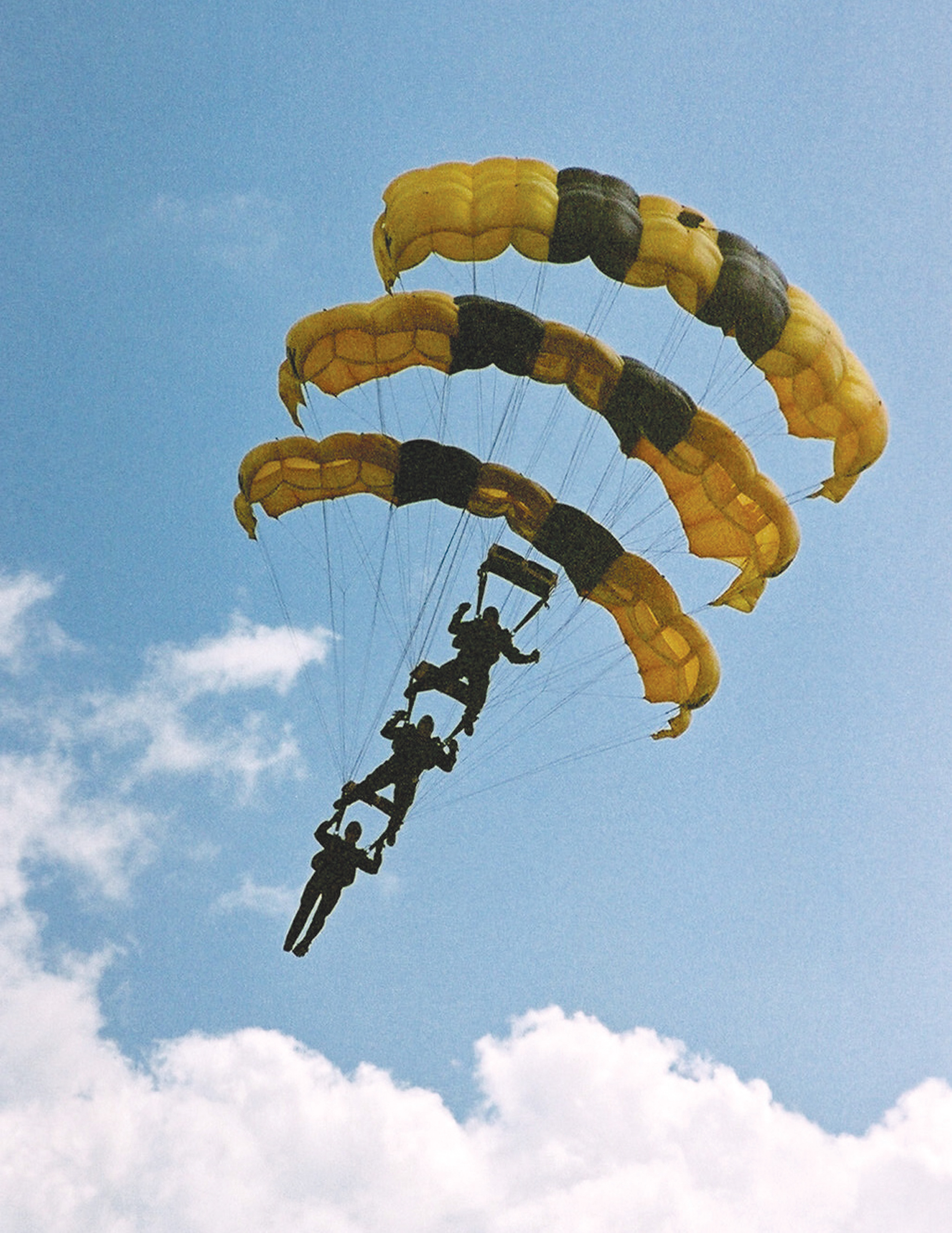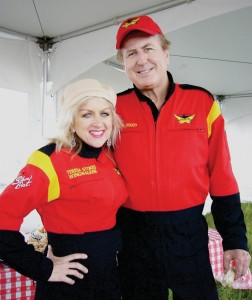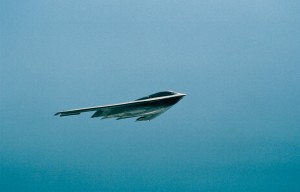By Jack Elliott

Three members of the Army Golden Knights Parachute Team drift in for a landing, one on top of the other.
Spectators flock to air shows to see spectacular performances by great aerobatic pilots. At the 13th annual “Wheels & Wings” Millville Airshow at Millville Airport, held May 20-22, there was no shortage of breathtaking sights in the skies.
The event attracted about 70,000 spectators. One of the most popular features of the weekend event is normally the Friday night air show. You don’t see a lot of night air show performances, especially in the East. It’s something very special, and it’s a big favorite at this southern Jersey show. When you see lighted aircraft performing aerobatics and formation flying in a dark sky, it’s something you don’t soon forget.
But there were a few complications this year. Friday was chilly, damp and gray. Unfriendly-looking clouds hung low in the sky. In spite of that, some performers were anxious to go on with the show.
“Even if I just fly back and forth over the runway,” one said.
The performers were ready to go, and there were a good number of spectators present. But when the FAA checked the weather, the ceiling was 700 feet. The canceling of the night show wasn’t an auspicious beginning for an event the show’s producers had spent nearly a year planning. But they weren’t fazed; there’s always tomorrow.
The sun was out the next morning, and the show went on, with 40,000 spectators there to see it. There were so many special performances in the show it’s hard to single them out. There were two headliner acts, the Canadian Snowbirds and the “Tora, Tora, Tora” reenactment of the attack on Pearl Harbor. In this event, aircraft with Japanese markings come swooping down as they did in the surprise attack on our Navy’s ships on Dec. 7. 1941, drawing the United States into World War II.
As they swooped low, explosions burst forth in leaping flames and black smoke. It was a realistic and frightening reminder of “The Day That Will Live in Infamy.” It was particularly appropriate on this occasion because it took place on Armed Forces Weekend.
The opening ceremonies were dedicated to the local men and women in service and particularly in respectful remembrance of those who gave their lives in defense of our country. The ceremonies ended with a jump by the Army’s Golden Knights parachute team to the playing of the National Anthem.
The Canadian Snowbirds closed the show. The Snowbirds perform with nine aircraft instead of the usual six, in tight formation. The additional aircraft enables them to do some more spectacular maneuvers. They’re favorites wherever they go and they don’t make a lot of appearances in the U.S.
There were a number of solo performers on the program, including Gene Soucy, who flies an unusual aircraft not normally used for aerobatics, a highly modified Grumman Ag Cat which he calls ShowCat. The solo performers included two New Jersey pilots who are favorites at air shows in the East, Ron Saglimbene, who performed here for the first time in his new, Italian-built SF260 Sia Marchetti, and Dave Hurley, whose Russian-built YAK-55 is a familiar sight at air shows.
Another favorite in these parts is Roger Lehnert, who makes a J-3 Cub do things that it’s not supposed to be able to do. If that weren’t enough, he comes back later to land the airplane on the world’s smallest airport, a platform on the back of a pickup truck. On this occasion, he set down on the teeny airport, but because of a strong crosswind he couldn’t hold it there and took off again. We’ve seen him perform that feat many times when conditions were less threatening.
Tim Weber in his Geico Extra 300 is another extraordinary solo performer who seems to recognize no limits in his routine of spectacular maneuvers. The show featured one unusual formation team, the Vultures, consisting of four homebuilt RV-8s and two Burt Rutan designs, the VariEze and the LongEze. The Rutan aircraft are an unusual sight in flight because they look like they’re flying backward. There are small wings up front known as canards, which look more like a tail, and the main wings are located back toward the rear.
In addition to the pilots, there are always special airplanes at shows like this that make the blood flow faster. A number of such airplanes made appearances here, some of which aren’t seen very often. In this category were the F-117A Stealth Fighter and the B-2A Spirit Stealth Bomber. The B-2A did its fly-bys only on Saturday. This aircraft doesn’t resemble a conventional airplane because it’s a flying wing—all wing, no fuselage. As it made its passes overhead it looked more like a big black bat in the sky than an aircraft.
The world’s biggest military airplane, the C-5B Galaxy, also did fly-bys on Saturday only. Among the aircraft that performed demonstrations were the F-117A Stealth Fighter, the F-15 Eagle fighter, the Navy’s F/A-18C Hornet fighter, and the Air Force’s C-17 cargo aircraft and KC-135 aerial refueling tanker. A warbird flight including the World War II P-47 Thunderbolt, P-51 Mustang, F4U Corsair and TBM torpedo bomber.
One more unusual exhibit was a Boeing 707, the nation’s first passenger jet. There are three of these aircraft still flying that are privately owned (including one owned by John Travolta). Tours were given of the aircraft featuring four bedrooms and a fully equipped kitchen.
If that weren’t enough to fill one’s day, a display of several hundred antique cars drew a lot of attention from the crowds who gawked at everything from an old Model T Ford to Packards, Studebakers and early model Thunderbirds.
For this spectator, the most memorable moments of the show came in the quiet of the Millville Army Airfield Museum tent on the flight line during a brief break in the action. Gene Soucy, one of the all-time greats of the air show circuit, was there with his diminutive wing-walker, Teresa Stokes, during a brief break before he took to the skies again.
For all the awards and honors that have come his way, Soucy is a non-assuming, friendly guy. Talking to him, you would never suspect that he was a three-time U.S. national champion and a three-time Canadian champion and that he flew for 25 years with both the Red Devil and Eagle top flight aerobatic teams.
When Soucy and Stokes perform together these days, they share something more than the flying experience. Stokes, Soucy’s wing walker and girlfriend of 16 years, discussed an emergency situation that occurred a couple of years ago of which many spectators aren’t aware. Doctors told Soucy that if he didn’t have a kidney transplant, he’d have to go on a dialysis machine.
I offered one of my kidneys but the doctors told him he would have to go to one of his family members first,” Stokes said. “They did that but couldn’t find a match. I was a perfect match.”
She donated one of her kidneys to Soucy.
“The procedure has been perfected so that they don’t have to make a big cut in your back anymore. I have a two-inch scar. I could wear a bikini if I wanted to,” she grinned. “I was out of the hospital in two days. Gene stayed a few more days.”
Within a few months, Soucy was ready to get back into action, and so was Stokes, but they couldn’t let the kidney transplant story out or no one would hire them. They kept quiet about it initially, and have now done about 30 shows since the transplant.















